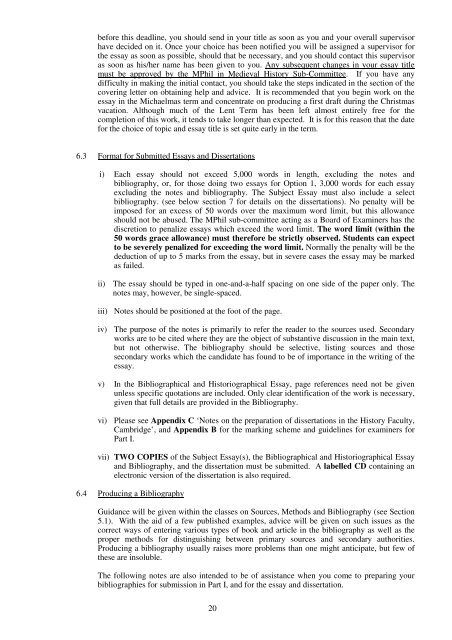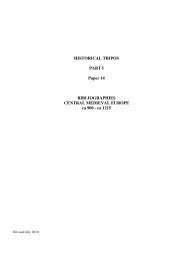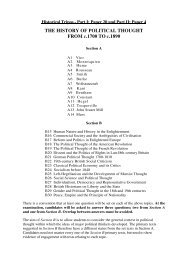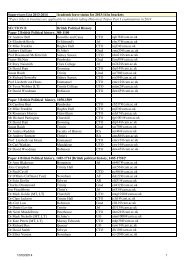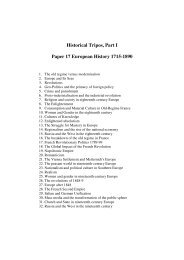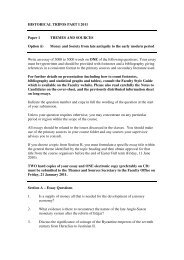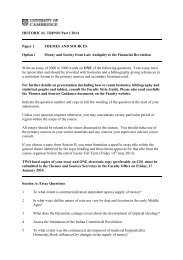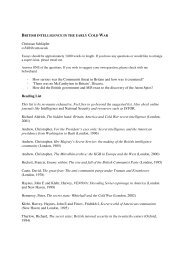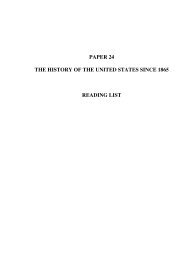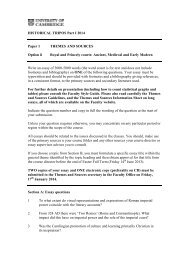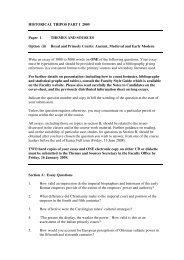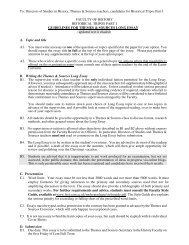Course Handbook - Faculty of History
Course Handbook - Faculty of History
Course Handbook - Faculty of History
You also want an ePaper? Increase the reach of your titles
YUMPU automatically turns print PDFs into web optimized ePapers that Google loves.
efore this deadline, you should send in your title as soon as you and your overall supervisor<br />
have decided on it. Once your choice has been notified you will be assigned a supervisor for<br />
the essay as soon as possible, should that be necessary, and you should contact this supervisor<br />
as soon as his/her name has been given to you. Any subsequent changes in your essay title<br />
must be approved by the MPhil in Medieval <strong>History</strong> Sub-Committee. If you have any<br />
difficulty in making the initial contact, you should take the steps indicated in the section <strong>of</strong> the<br />
covering letter on obtaining help and advice. It is recommended that you begin work on the<br />
essay in the Michaelmas term and concentrate on producing a first draft during the Christmas<br />
vacation. Although much <strong>of</strong> the Lent Term has been left almost entirely free for the<br />
completion <strong>of</strong> this work, it tends to take longer than expected. It is for this reason that the date<br />
for the choice <strong>of</strong> topic and essay title is set quite early in the term.<br />
6.3 Format for Submitted Essays and Dissertations<br />
i) Each essay should not exceed 5,000 words in length, excluding the notes and<br />
bibliography, or, for those doing two essays for Option 1, 3,000 words for each essay<br />
excluding the notes and bibliography. The Subject Essay must also include a select<br />
bibliography. (see below section 7 for details on the dissertations). No penalty will be<br />
imposed for an excess <strong>of</strong> 50 words over the maximum word limit, but this allowance<br />
should not be abused. The MPhil sub-committee acting as a Board <strong>of</strong> Examiners has the<br />
discretion to penalize essays which exceed the word limit. The word limit (within the<br />
50 words grace allowance) must therefore be strictly observed. Students can expect<br />
to be severely penalized for exceeding the word limit. Normally the penalty will be the<br />
deduction <strong>of</strong> up to 5 marks from the essay, but in severe cases the essay may be marked<br />
as failed.<br />
ii) The essay should be typed in one-and-a-half spacing on one side <strong>of</strong> the paper only. The<br />
notes may, however, be single-spaced.<br />
iii) Notes should be positioned at the foot <strong>of</strong> the page.<br />
iv) The purpose <strong>of</strong> the notes is primarily to refer the reader to the sources used. Secondary<br />
works are to be cited where they are the object <strong>of</strong> substantive discussion in the main text,<br />
but not otherwise. The bibliography should be selective, listing sources and those<br />
secondary works which the candidate has found to be <strong>of</strong> importance in the writing <strong>of</strong> the<br />
essay.<br />
v) In the Bibliographical and Historiographical Essay, page references need not be given<br />
unless specific quotations are included. Only clear identification <strong>of</strong> the work is necessary,<br />
given that full details are provided in the Bibliography.<br />
vi) Please see Appendix C ‘Notes on the preparation <strong>of</strong> dissertations in the <strong>History</strong> <strong>Faculty</strong>,<br />
Cambridge’, and Appendix B for the marking scheme and guidelines for examiners for<br />
Part I.<br />
vii) TWO COPIES <strong>of</strong> the Subject Essay(s), the Bibliographical and Historiographical Essay<br />
and Bibliography, and the dissertation must be submitted. A labelled CD containing an<br />
electronic version <strong>of</strong> the dissertation is also required.<br />
6.4 Producing a Bibliography<br />
Guidance will be given within the classes on Sources, Methods and Bibliography (see Section<br />
5.1). With the aid <strong>of</strong> a few published examples, advice will be given on such issues as the<br />
correct ways <strong>of</strong> entering various types <strong>of</strong> book and article in the bibliography as well as the<br />
proper methods for distinguishing between primary sources and secondary authorities.<br />
Producing a bibliography usually raises more problems than one might anticipate, but few <strong>of</strong><br />
these are insoluble.<br />
The following notes are also intended to be <strong>of</strong> assistance when you come to preparing your<br />
bibliographies for submission in Part I, and for the essay and dissertation.<br />
20


